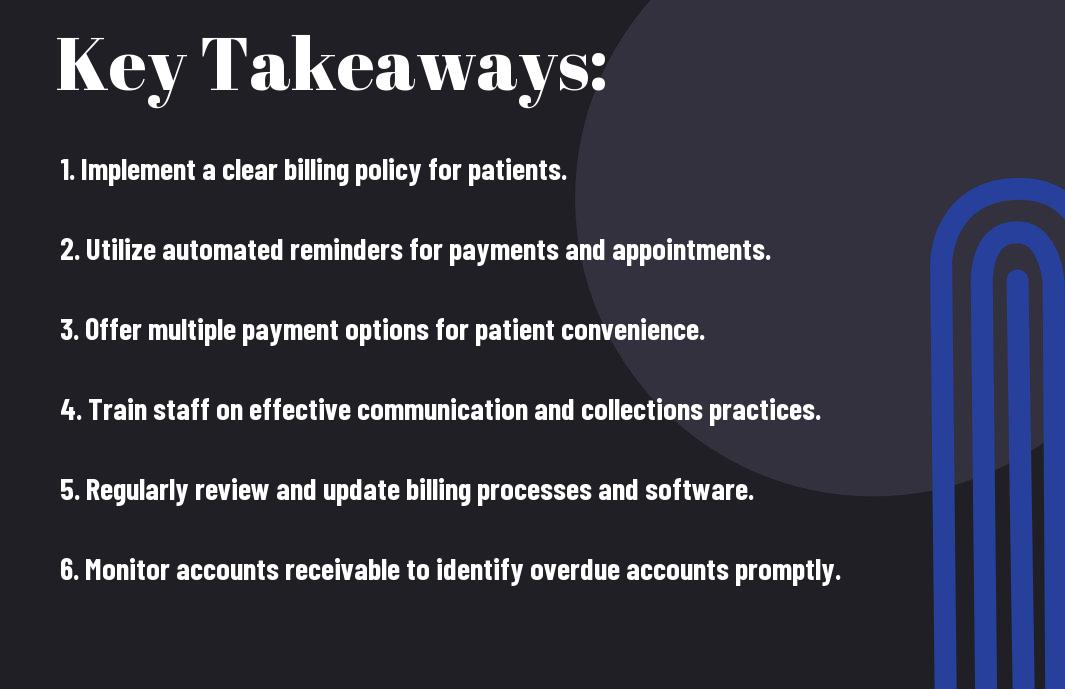Streamlining Your Collections Process – Steps Every Dental Office Should Take Today
Process improvement in your dental office’s collections is crucial for financial health. I have seen firsthand how a streamlined collections process can lead to increased cash flow and reduced outstanding balances. By implementing straightforward steps, I can help you transform your current practices, minimize patient stress during payment, and ensure that your revenue cycle runs smoothly. In this post, I’ll share practical strategies to enhance your collections, making your practice more efficient and allowing you to focus on providing quality patient care.
Key Takeaways:
- Implement a clear and consistent billing policy to ensure patients understand payment expectations upfront.
- Utilize technology tools such as automated reminders and online payment options to simplify the collections process.
- Train staff on effective communication strategies to address billing inquiries and payment plans with empathy.
- Establish a follow-up system for overdue accounts to maintain engagement and increase recovery rates.
- Regularly review and analyze your collections process to identify areas for improvement and enhance efficiency.


Understanding the Collections Process
To effectively manage your dental practice’s revenue, it’s vital to understand each stage of the collections process. This involves everything from setting clear payment policies to sending out invoices and following up on outstanding accounts. By grasping how these elements interconnect, you can create a robust system that minimizes loss and ensures your practice remains financially healthy.
Importance of an Efficient Collections Process
Against the backdrop of rising operational costs, an efficient collections process can significantly enhance your practice’s cash flow. It ensures timely payments, reduces patient anxiety regarding billing, and optimally positions you to focus on patient care rather than financial stress. Incorporating streamlined collections can make a noticeable difference in your overall productivity.
Common Challenges Faced by Dental Offices
Around many dental practices, there are persistent challenges that hinder effective collections. Issues such as unclear financial policies, inconsistent follow-up on unpaid accounts, and patient reluctance to discuss payment plans often lead to delayed payments. Identifying these roadblocks early on can be the first step toward a more effective system.
Also, I find that outdated billing software and staff training deficits are prevalent issues that can complicate the collections process. When employees aren’t well-trained on collections protocols, it results in inefficiencies and confused communication with patients. Additionally, patient misunderstandings about their insurance coverage can lead to frustration and reluctance to pay. Addressing these challenges head-on can pave the way for a more streamlined approach, improving your bottom line while keeping your patients satisfied.
Establishing Clear Financial Policies
The foundation of an effective collections process begins with establishing clear financial policies. By outlining payment expectations, procedures for overdue accounts, and any penalties or incentives for prompt payments, I ensure that my dental practice operates smoothly. These policies not only minimize misunderstandings but also fosters trust between my staff and patients, creating a more positive experience for everyone involved.
Creating Transparent Payment Plans
After defining financial policies, I focus on creating transparent payment plans that suit the varying needs of my patients. Offering flexible options allows me to accommodate individuals while ensuring that my practice stays financially healthy. I provide detailed explanations on how these plans work, which helps alleviate any concerns patients may have about costs upfront.
Communicating Policies with Patients
Plans are only effective if patients are well-informed about them. I make it a priority to communicate my financial policies clearly, both verbally and in writing, during their visits. The goal is to foster an environment of transparency that encourages questions and eliminates confusion regarding payments. When I consistently discuss these policies, I empower patients to take ownership of their financial obligations, which in turn results in timely payments and a healthier practice. Additionally, sharing these details during the scheduling process and following up with written reminders can enhance understanding and adherence to the plans.

Utilizing Technology for Collections
Now, integrating technology into your collections process can significantly enhance efficiency and effectiveness. I recommend exploring tools that automate billing and follow-ups to minimize delays. For more strategies, check out How Dentists Can Enhance Billing and Collection Process. Embracing modern solutions will ensure your practice thrives while improving patient satisfaction.
Implementing Practice Management Software
Around the dental community, practice management software is becoming an crucial asset for simplifying operations. By using this type of software, I can automate appointment scheduling, patient communications, and billing, which minimizes manual errors and saves valuable time. Adopting these systems allows me to focus more on patient care and less on paperwork.
Utilizing Automated Payment Reminders
Practice implementing automated payment reminders can streamline the collection process significantly. I find that by sending reminders via text or email, patients are more likely to settle their balances promptly. This proactive approach helps maintain cash flow while also ensuring patients do not overlook their financial responsibilities.
Further, utilizing automated payment reminders minimizes the effort required from both your office staff and your patients. With *consistent* and *timely* notifications, you’ll witness an increase in on-time payments, which enhances your overall collections. Not only does this method save valuable time, but it also fosters *positive* relationships with your patients, making them more likely to return for future services. Ensure you set reminders to go out at strategic intervals—like a week before the due date—as this keeps your practice running smoothly and mitigates *delays* in revenue collection.
Training Your Staff
After establishing clear protocols for your collections process, it’s vital to invest time in training your staff. Everyone in your dental office, from the front desk to the treatment teams, should understand their role in ensuring efficient collections. By fostering a culture of accountability and education, you will equip your team with the skills and confidence to handle patient accounts effectively. Regular training sessions and updates on best practices will keep your team engaged and informed, leading to improved collections and enhanced patient experiences.
Empowering Front Desk Teams
Above all, empowering your front desk teams is crucial for achieving success in your collections efforts. When these team members are well-trained and confident in their abilities, they can effectively communicate financial policies and handle inquiries or concerns from patients. I encourage you to provide them with comprehensive training so they can feel equipped to discuss payments respectfully, and the importance of prioritizing your practice’s revenue cycle becomes evident.
Strategies for Effective Patient Communication
Across your dental practice, effective communication can significantly enhance how you manage collections. I find that taking the time to explain the financial aspects of treatment before services are provided can lead to greater patient understanding and acceptance of their payment responsibilities. By being transparent about costs, alternative payment plans, and insurance coverage, you can build trust with patients and reduce misunderstandings about billing.
It’s vital to implement friendly and clear communication strategies when discussing financial matters with patients. I suggest utilizing personalized messages and reminders that reflect each patient’s unique situation. This can involve following up after appointments to discuss pending balances or providing tailored payment plans that accommodate their financial capabilities. Additionally, utilizing a compassionate tone can transform potentially difficult conversations into collaborative problem-solving opportunities, leading to higher patient satisfaction and increased collections.
Reviewing and Analyzing Collections Data
Your collections data holds valuable insights that can enhance your dental practice’s financial performance. By regularly reviewing and analyzing this data, you can identify trends, spot potential issues, and streamline processes. I recommend diving deeper into the metrics related to unpaid claims and patient payment patterns. For a more in-depth understanding, check out Mastering Dental Collections: A Comprehensive Guide to further refine your strategy.
Monitoring Key Performance Indicators
Against the backdrop of your financial goals, keeping an eye on key performance indicators (KPIs) is imperative. I find that monitoring metrics such as the days in accounts receivable and collection rates can highlight areas that need attention. By evaluating how these KPIs perform over time, you can gain insights into the effectiveness of your collections process.
Adjusting Strategies Based on Data Insights
An effective collections process is dynamic and must adjust based on data insights. It’s important to evaluate whether your current strategies are yielding the desired results. If not, you might need to explore different payment plans or communication methods to engage patients better.
In fact, analyzing trends in your collections data can reveal significant opportunities for improvement. For example, you might discover that patients who receive personalized payment reminders have a higher percentage of on-time payments. Alternatively, if you notice spikes in late payments among specific demographics, this could signal a need for targeted payment options or education regarding your billing procedures. Utilizing data insights, you can proactively adapt your strategies, improving both patient experience and your bottom line.
Creating a Follow-Up System
Many dental offices lack a structured follow-up system, leading to missed payments and decreased cash flow. By implementing an organized follow-up strategy, you can maintain ongoing communication with patients regarding their outstanding balances, which helps to improve the likelihood of timely payments.
Scheduling Regular Follow-Ups
Against the common practice of sporadic communications, I encourage you to establish a routine for following up with patients. Schedule regular intervals for reminders, whether it’s through phone calls, emails, or texts, to keep your practice on their radar and encourage timely payments.
Handling Delinquent Accounts
Beside implementing reminders for regular payments, handling delinquent accounts requires a different approach. It’s vital to have a clear policy in place for addressing overdue balances while ensuring you maintain a professional relationship with your patients.
Accounts that remain overdue can significantly impact your practice’s cash flow. I find that implementing a systematic approach, such as sending gentle reminders for payment followed by stricter measures if necessary, is effective. It’s important to convey a sense of urgency without compromising your relationship with the patient. If accounts remain unresolved, you might consider offering payment plans or, as a last resort, involving a collection agency. Be mindful of, clear communication is vital; your goal is a resolution that works for both your practice and your patients.
To wrap up
Considering all points, streamlining your collections process is necessary for the financial health of your dental practice. By implementing the steps I’ve discussed, you can reduce the challenges associated with collections and improve your cash flow. I encourage you to explore 9 Tips For Dental Patient Collections Process Profitability to further enhance your approach. Taking action today will lead to a more efficient and profitable collections process, benefitting both you and your patients.
FAQ
Q: What is the first step to streamlining the collections process in a dental office?
A: The first step is to assess your current collections process. This involves reviewing your existing protocols, payment options, and communication methods with patients. Understanding where improvements are needed lays the foundation for an efficient collections strategy.
Q: How can dental offices enhance patient communication regarding payments?
A: Dental offices can enhance communication by providing clear and transparent information about payment policies during the initial consultation and through follow-up reminders. Utilizing multiple channels, such as email, text messages, and phone calls, can also improve patient understanding and compliance.
Q: What technology solutions can help ease the collections process?
A: Implementing dental practice management software that integrates billing and collections features can significantly streamline operations. Solutions that allow automatic invoicing, online payment options, and easy tracking of account status can enhance efficiency and reduce errors in the collections process.
Q: How can a dental office effectively handle overdue accounts?
A: Establishing a systematic follow-up plan for overdue accounts is important. This may involve sending reminder notices at set intervals, using polite but firm language, and possibly offering flexible payment plans to help patients settle their balances while maintaining a positive relationship.
Q: What role does staff training play in the collections process?
A: Staff training plays a vital role in ensuring that everyone in the office understands the collections process and can communicate it effectively to patients. Regular training sessions can help staff stay updated on policies, improve their skills in handling sensitive conversations, and ensure they are well-versed in using collection tools.
Q: How can patient payment options impact the collections process?
A: Offering a variety of payment options can greatly increase the likelihood of timely payments. Accepting credit cards, payment plans, and even mobile payment methods make it more convenient for patients to settle their accounts. This flexibility can lead to improved cash flow for the practice.
Q: What should a dental office do if internal efforts to collect payments fail?
A: If internal efforts to collect payments are not effective, it may be time to consider outsourcing collections to a professional third-party service. These specialized agencies often have different strategies and resources for recovering overdue accounts while ensuring compliance with relevant laws and regulations.




